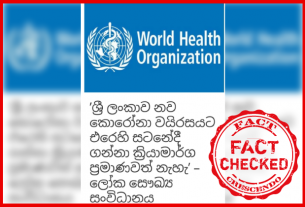Fact Checked by G. Rashmitha Diwyanjalee
Subscribe to our WhatsApp Channel
Food additives are substances added to food to enhance its flavor, appearance, texture, or shelf life. They serve various functions, including preserving food, improving taste, and maintaining consistency. These additives have been used for centuries, with ancient practices including the use of salt and vinegar for preservation and spices for coloring. However, as our understanding of these substances deepens, so do the concerns regarding their potential health risks.
In recent years, public concern has shed light on the possible dangers of certain food additives, particularly antioxidants, which are commonly used to prevent food from spoiling. This article aims to provide insights into antioxidants with their E numbers, their usage, regulations in Sri Lanka, and research findings on their health effects.
Social Media Posts
Recently, a poster on social media claimed that food products containing antioxidants (E 310, E 311, E 312, E 319, and E 320) are not suitable for children under the age of 3 Years.
We decided to do a fact check on these.
E Number Range and Additive Types
Antioxidants are a specific type of food additive that protects food from oxidative deterioration, which can cause rancidity and loss of flavour, colour, and nutritional quality. By preventing oxidation, antioxidants extend the shelf life of food products.
While these substances are effective in preserving food, some research has indicated potential health risks associated with their excessive consumption, particularly for young children.
Professor Melinda Coughlan from Monash University explained that The “E numbers” in ingredient lists of packaged foods replace the chemical or common names of specific food additives. These additives enhance colour, flavour, texture, or prevent food spoilage. E numbers are standardised in Europe (E stands for Europe) and are identified by their code numbers in Australia. For example, vitamin C is labelled as E300 in Europe and can be found as code 300 in Australia.
Number range/ E Additive type
100-199 Food colors
200-299 Preservatives
200-299 Antioxidants
400-499 Thickeners, emulsifiers and stabilizers
500-599 Acidity regulators and anti-caking agents
600-699 Flavor enhancers
700-999 Sweeteners, foaming agents and gases
Claim 1: Antioxidants should banned in foods for infants and children
Facts
The President of the Public Health Inspector’s Union of Sri Lanka (Mr. M.G Upul Rohana) said his opinion on this poster as, “This message is not published by our association or any of our affiliates. However, the technical facts stated here are true.”
Food (Antioxidants) Regulations 2009 – No.1617/16 clearly mention that “no food intended for infants and young children shall have in or upon it any antioxidants or a combination thereof specified in items 1,2 and 3 of Column 1 of Schedule 1”. 1,2 and 3 of Column represent the antioxidants (E 310, E 311, E 312, E 319, and E 320). More details can be read here. However, the regulation provide permission to certain food antioxidants that may added to specified food and maximum permitted proportion of each antioxidants for adults’ consumption.
Statement of the Sri Lanka Standards Institution (SLSI):
The “Codex General Standard for Food Additives” (GSFA, Codex STAN 192-1995) sets conditions for permitted food additives in all foods. In Sri Lanka, not all Codex-listed additives are allowed for consumption. The Sri Lankan government’s Food Act provides guidelines for certain food additives in Codex, and any additives outside the act require permission from the Health Ministry.
The Food (Antioxidants) Regulations 2009 outline that antioxidants prolong the shelf life of foods by protecting them from oxidation. The act specifies acceptable antioxidants and their maximum permissible concentrations in various food items.
| Antioxidant | Chemical formula | INS No. | Specified food | Maximum proportion in milligrams per kilogram of food |
| Propyl gallate | C10H12O5 | E 310 | Edible fats and oils, margarine, fat spread, salad oils, lard and drippings | 100 |
| Octyl gallate | C15H22O5 | E 311 | ||
| Dodecyl gallate | C19H30O5 | E312 | ||
| or Mixtures thereof | Essential oils | 1000 | ||
| Tert-Butyl hydroquinone (TBQH) | C10H14O2 | E 319 | Edible fatty acid oils, margarine, fat spread, salad oils, lard and dripping | 200 |
| Essential oils | 1000 | |||
| t-Butyl-4-methoxyphenol, butylated hydroxyanisole (BHA) | C11H16O2 | E 320 | Edible fatty acid oils, margarine, fat spread, salad oils, lard and dropping | 200 |
| Essential oils | 1000 |
A Research-Based Exploration- The Hidden Dangers of Food Antioxidants
- E310 (Propyl Gallate) -Although, there were concerns regarding its potential role in promoting tumor growth in experimental settings in 1994 (Tuormaa, 1994), recent research indicates that propyl gallate may induce allergic reactions in sensitive individuals (EFSA).
- E311 (Octyl Gallate) and E312 (Dodecyl Gallate) – Both of these have been implicated in causing allergic reactions. Additionally, studies have found these compounds can leave residues of organochlorine, which are persistent and potentially harmful environmental pollutants (Silva, 2016).
- E319 (Tertiary-Butyl Hydroquinone, TBHQ) – when consumed in high doses over prolonged periods, has been associated with carcinogenic effects in animal studies. Although regulatory authorities, such as the European Food Safety Authority (EFSA), have deemed TBHQ safe within authorized limits, the potential risks at higher doses warrant caution (Gharavi & Kadi, 2005; EFSA, 2004; Race, 2009).
- E320 (Butylated Hydroxyanisole, BHA) – It has been linked to the production of free radicals when consumed with large amounts of Vitamin C, potentially leading to DNA damage. BHA has been banned in Japan since 1958 due to its association with tumor formation in animal studies. Additionally, it can cause irritation to the skin, eyes, and respiratory system (IvyRose, 2024).
- Combined Effects of Food Additives – A study by Groten et al. (2000) explored the joint actions and interactions of various food additives. The study concluded that, while few combined effects were identified.
Usage Restrictions
- Infants and Young Children: Due to the risk of methemoglobinemia and other health concerns, gallates (E 310, E 311, and E 312) are banned in foods intended for infants and young children.
- Regulations: The use of gallates is regulated by food safety authorities. In Sri Lanka, for instance, the Food Act and specific regulations stipulate the permissible levels of these antioxidants in various food products for adults’ consumption.
Therefore, The Public Health Inspector’s Union of Sri Lanka confirms that the technical facts stated in the social media message are true. The research indicates potential health risks associated with certain antioxidants, supporting the claim that these food products should be avoided for children under the age of 3 Years.
Follow us and stay up to date with our latest fact checks.
Facebook | Twitter | Instagram | Google News | TikTok

Title:Unpacking the Hidden Dangers of Food Additives: Are Your Snacks Safe?
Fact Check By: Rashmitha DiwanjaleeResult: Insight






